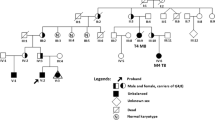Summary
A family in which the proband showed phenotypic signs of both the Turner and Down syndromes was studied cytogenetically and with restriction fragment length polymorphisms. The proband's karyotype was 46,X,+21, showing double aneuploidy without any signs of mosaicism. The single X and one chromosome 21 were of paternal origin while two chromosomes 21 were of maternal origin. The nondisjunction of chromosome 21 took place in maternal meiosis II. If it is assumed that the absence of mosaicism renders postzygotic mitotic loss of the X chromosome unlikely, then the X chromosome would have been lost in maternal meiosis I or II. Recombination had occurred between the nondisjoined chromosomes 21. We conclude that double nondisjunction took place in one parent and that asynapsis was not a prerequisite for the autosomal nondisjunction.
Similar content being viewed by others
References
Alfi OS, Chang R, Azen SP (1980) Evidence for genetic control of nondisjunction in man. Am J Hum Genet 32:477–483
Baguena Candela R, Forteza Bover G, Ortitz Hernandez MD, Comin Ferrer J (1966) Un caso con estigmas del sindrome de Bonnevie-Ullrich y. de mongolismo y cariotipo 45/XO-trisomia G. Med Espanola 4:454–461
Baker BS, Carpenter ATC, Esposito MS, Esposito RE, Sandler L (1976) The genetic control of meiosis. Annu Rev Genet 10:53–134
Dagna Bricarelli F, Pierluigi M, Perroni L, Grasso M, Arslanian A, Sacchi N (1988) High efficiency in the attribution of parental origin of non-disjunction in trisomy 21 by both cytogenetic and molecular polymorphisms. Hum Genet 79:124–127
Davies KE, Harper K, Bonthron D, Krumlauf R, Polkey A, Pembrey ME, Williamson R (1984) Use of a chromosome 21 cloned DNA probe for the analysis of nondisjunction in Down syndrome. Hum Genet 66:54–56
Donis-Keller H, Green P, Helms C, Cartinhour S, Weiffenbach B, Stephens K, Keith TP, Bowden DW, Smith DR, Lander ES, Botstein D, Akots G, Rediker KS, Gravius T, Brown VA, Rising MB, Parker C, Powers JA, Watt DE, Kauffman ER, Bricker A, Phipps P, Muller-Kahle H, Fulton TR, Ny S, Schumm JW, Braman JC, Knowlton RG, Barker DF, Crooks SM, Lincoln SE, Daly MJ, Abrahamson J (1987) A genetic linkage map of the human genome. Cell 51:319–337
Hamers AJH, Vaes-Peeters GPM, Jongbloed RJE, Millington-Ward AM, Meijer H, Die-Smulders CEM de, Geraedts JPM (1987) On the origin of recurrent trisomy 21: determination using chromosomal and DNA polymorphisms. Clin Genet 32:409–413
Hansmann I, Jenderny J, Probeck HD (1983) Low doses of X-rays decrease the risk of diploidy in mouse oocytes. Mutat Res 109:99–110
Hassold TJ (1985) The origin of aneuploidy in humans. In: Dellarco VL, Voytek PE, Hollaender A (eds) Aneuploidy. Plenum Press, New York, pp 103–115
Hassold T, Jacobs PA (1984) Trisomy in man. Annu Rev Genet 18:69–97
Hassold TJ, Chiu D, Yamane JA (1984) Parental origin of autosomal trisomies. Ann Hum Genet 48:129–144
Henderson SA, Edwards RG (1968) Chiasma frequency and maternal age in mammals. Nature 218:22–28
Hofker MH, Wapenaar MC, Goor N, Bakker B, Ommen EJB van, Pearson PL (1985) Isolation of probes detecting restriction fragment length polymorphisms from X chromosome specific libraries: potential use for diagnosis of Duchenne muscular dystrophy. Hum Genet 70:259–274
Hook EB (1985) Maternal age, paternal age, and human chromosomal abnormality: nature, magnitude, etiology, and mechanisms of effects. In: Dellarco VL, Voytek PE, Hollaender A (eds) Aneuploidy. Plenum Press, New York, pp 117–132
Laurie DA, Hultén MA (1985) Further studies on bivalent chiasma frequency in human males with normal karyotypes. Ann Hum Genet 49:189–201
McCorquodale MM, Cummins T, Furlong J (1985) Prenatal diagnosis of trisomy 21 and X/XX sex chromosome mosaicism. Prenat Diagn 5:295–298
Millington-Ward AM, Pearson PL (1988) Use of restriction fragment length polymorphic probes in the analysis of Down's syndrome trisomy. Hum Genet 80:362–370
Page DC, Chapelle A de la (1984) The parental origin of X chromosomes in XX males determined using restriction fragment length polymorphisms. Am J Hum Genet 36:565–575
Polani PE, Jagiello GM (1976) Chiasmata, meiotic univalents and age in relationship to aneuploid imbalance in mice. Cytogenet Cell Genet 16:505–529
Sacchi N, Gusella JF, Perroni L, Dagna Bricarelli F, Papas TS (1988) Lack of evidence for association of meiotic nondisjunction with particular DNA haplotypes on chromosome 21. Proc Natl Acad Sci USA 85:4794–4798
Sanger R, Tippett P, Gavin J, Teesdale P, Daniels GL (1977) Xg groups and sex chromosome abnormalities in people of northern European ancestry: an addendum. J Med Genet 14:210–213
Stene J, Stene E, Mikkelsen M (1984) Risk for chromosome abnormality at amniocentesis following a child with a non-inherited chromosome aberration. Prenat Diagn 4:81–95
Stewart GP, Hassold TJ, Berg A, Watkins P, Tanzi R, Kurnit DM (1988) Trisomy 21 (Down syndrome): studying nondisjunction and meiotic recombination by using cytogenetic and molecular polymorphisms that span chromosome 21. Am J Hum Genet 42: 227–236
Tamaren J, Spuhler K, Sujansky E (1983) Risk of Down syndrome among second- and third-degree relatives of a proband with trisomy 21. Am J Med Genet 15:393–403
Townes PL, White MR, Stiffler SJ, Goh K (1975) Double aneuploidy. Am J Dis Child 129:1062–1065
Warburton D (1985) Genetic factors influencing aneuploidy frequency. In: Dellarco VL, Voytek PE, Hollaender A (eds) Aneuploidy. Plenum Press, New York, pp 133–148
Warren AC, Chakravart A, Wong C, Slaugenhaupt SA, Halloran SL, Watkins PC, Metaxotou C, Antonarakis SE (1987) Evidence for reduced recombination on the nondisjoined chromosomes 21 in Down syndrome. Science 237:652–654
Author information
Authors and Affiliations
Rights and permissions
About this article
Cite this article
Ikonen, R.S., Lindlöf, M., Janas, M.O. et al. Coincident maternal meiotic nondisjunction of chromosomes X and 21 without evidence of autosomal aysnapsis. Hum Genet 83, 235–238 (1989). https://doi.org/10.1007/BF00285163
Received:
Revised:
Issue Date:
DOI: https://doi.org/10.1007/BF00285163




